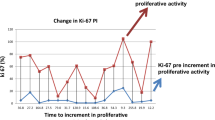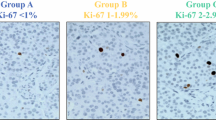Abstract
The incidence of well-differentiated non-functioning pancreatic neuroendocrine tumors (NF-PanNET) increased during the last decades. The risk of relapse after curative surgery, albeit low, is not negligible; moreover, adjuvant treatment is currently not an option and a reliable predictive model based on prognostic characteristics is urgently needed for tailoring a follow-up strategy. The histological classification of PanNET now relies only on the proliferative activity (mitosis and Ki67) and staging. In contrast to other endocrine neoplasms, the role of infiltrative growth pattern in NF-PanNET is not taken into consideration at present. In the current study, 247 consecutive patients who underwent surgical resection for a NF-PanNET were examined for the histological growth pattern of the tumor. Two distinct patterns (non-infiltrative vs. infiltrative) were described with the latter being further subclassified according to the type of structures invaded by the tumor (non-infiltrative: pattern 1; infiltration of adjacent pancreatic parenchyma and/or peripancreatic soft tissue: pattern 2; invasion of nearby organs and/or major vessels: pattern 3). The infiltrative growth resulted to be strongly associated with a poorer survival compared to a non-infiltrative growth (p < 0.001). In particular, the distinction between pancreatic parenchyma and/or peripancreatic soft tissue invasion versus adjacent organs and/or major vessels invasion was the most powerful predictor of recurrence after surgery at multivariate analysis (pattern 2 vs. pattern 1: HR 10.136, p = 0.028; pattern 3 vs. pattern 1: HR 15.775, p = 0.015). The infiltrative growth pattern could therefore provide additional prognostic information implementing the current grading and staging system.






Similar content being viewed by others
Availability of Data and Materials
Any datasets used in this paper can be accessed on reasonable request to the corresponding author.
References
De Lellis RA, Lloyd RV, Heitz PU et al. WHO Classification of Tumours, Pathology and Genetics of Tumours of Endocrine Organs. Lyon: IARC Press, editor. 2004.
WHO Classification of Tumours Editorial Board, Digestive System Tumours, 5th ed. Lyon: IARC Press; 2019.
Strosberg JR, Cheema A, Weber JM, Ghayouri M, Han G, Hodul PJ and Kvols LK. Relapse-free survival in patients with nonmetastatic, surgically resected pancreatic neuroendocrine tumors: An analysis of the AJCC and ENETS staging classifications. Ann Surg. 2012;256(2):321–5. https://doi.org/10.1097/SLA.0b013e31824e6108.
Partelli S, Landoni L, Andreasi V, Nessi C, Muffatti F, Crippa S et al. Pattern of disease recurrence and treatment after surgery for nonfunctioning well-differentiated pancreatic neuroendocrine tumors. Surgery. 2020 Nov; 168(5):816–24. https://doi.org/10.1016/j.surg.2020.06.034.
Zaidi MY, Lopez-Aguiar AG, Switchenko JM, Lipscomb J, Andreasi V, Partelli S et al. A Novel Validated Recurrence Risk Score to Guide a Pragmatic Surveillance Strategy after Resection of Pancreatic Neuroendocrine Tumors: An International Study of 1006 Patients. Ann Surg. 2019;270(3):422–33. https://doi.org/10.1097/SLA.0000000000003461.
Genç CG, Jilesen AP, Partelli S, Falconi M, Muffatti F, van Kemenade FJ et al. A New Scoring System to Predict Recurrent Disease in Grade 1 and 2 Nonfunctional Pancreatic Neuroendocrine Tumors. Ann Surg. 2018;267(6):1148–54. https://doi.org/10.1097/SLA.0000000000002123.
Pulvirenti A, Pea A, Chang DK and Jamieso JB. Clinical and Molecular Risk Factors for Recurrence Following Radical Surgery of Well-Differentiated Pancreatic Neuroendocrine Tumors. Front Med. 2020; August 5/7:385. https://doi.org/10.3389/fmed.2020.00385.
Pulvirenti A, Javed AA, Landoni L, Jamieson NB, Chou JF, Miotto M et al. Multi-institutional Development and External Validation of a Nomogram to Predict Recurrence after Curative Resection of Pancreatic Neuroendocrine Tumors. Ann Surg. 2021;274(6):1051–7. https://doi.org/10.1097/SLA.0000000000003579.
Lloyd, RV, Osamura, RY, Kloppel G and Rosai J. WHO Classification of Tumours of Endocrine Organs. 4th ed. Lyon: IARC Press 2017.
Sobin L, Gosporadowicz M and Wittekind C TNM Classification of Malignat Tumours 7th ed. Oxford, UK; Hoboken N. JW& S, editor. 2009.
AJCC Cancer Staging Manual, Seventh Edition, New York: Springer, 2010.
Brierley JD, Gospodarowicz MK and Wittekind C. TNM Classification of Malignant Tumours. 8th ed. Oxford, UK; Hoboken N. JW& S, editor. 2017.
AJCC Cancer Staging Manual, Eighth Edition, New York: Springer, 2017.
Chatterjee D, Trikalinos NA, Williams GA, Liu J, Hawkins WG and Hammill C. Intratumoral Fibrosis and Tumor Growth Pattern as Prognostic Factors in Optimally Resected Pancreatic Neuroendocrine Neoplasms: An Analysis of 168 Cases. Pancreas. 2020;49(2):255–60. https://doi.org/10.1097/MPA.0000000000001478.
Taskin OC, Reid MD, Bagci P, Armutlu A, Demirtas D, Pehlivanoglu B et al. Infiltration pattern predicts metastasis and progression better than the T-stage and grade in pancreatic neuroendocrine tumors: a proposal for a novel infiltration-based morphologic grading. Mod Pathol. 2022 Jun;35(6):777-785. https://doi.org/10.1038/s41379-021-00995-4.
von Elm E, Altman DG, Egger M, Pocock SJ, Gøtzsche PC and Vandenbroucke JP. The strengthening the reporting of observational studies in epidemiology (STROBE) statement: Guidelines for reporting observational studies. Int J Surg 2014;12(12):1495–9. https://doi.org/10.1016/j.ijsu.2014.07.013.
Rindi G, Mete O, Uccella S, Basturk O, La Rosa S, Brosens LAA et al. Overview of the 2022 WHO Classification of Neuroendocrine Neoplasms. Endocr Pathol. 2022 Mar;33(1):115-154. https://doi.org/10.1007/s12022-022-09708-2. Epub 2022 Mar 16.
Luong TV, Watkins J, Chakrabarty B and Wang LM. Standards and datasets for reporting cancers Dataset for histopathological reporting of neuroendocrine neoplasms of the gastroenteropancreatic tract October 2019. The Royal College of Pathologist.
Marchegiani G, Landoni L, Andrianello S, Masini G, Cingarlini S, D’Onofrio M et al. Patterns of Recurrence after Resection for Pancreatic Neuroendocrine Tumors: Who, When, and Where? Neuroendocrinology. 2019;108(3):161–71. https://doi.org/10.1159/000495774.
Falconi M, Eriksson B, Kaltsas G, Bartsch DK, Capdevila J, Caplin M et al. ENETS consensus guidelines update for the management of patients with functional pancreatic neuroendocrine tumors and non-functional pancreatic neuroendocrine tumors. Neuroendocrinology. 2016;103(2):153–71. https://doi.org/10.1159/000443171.
Pavel M, Öberg K, Falconi M, Krenning EP, Sundin A, Perren A et al. Gastroenteropancreatic neuroendocrine neoplasms: ESMO Clinical Practice Guidelines for diagnosis, treatment and follow-up. Ann Oncol. 2020;31(7):844–60. https://doi.org/10.1016/j.annonc.2020.03.304.
Hochwald SN, Zee S, Conlon KC, Colleoni R, Louie O, Brennan MF et al. Prognostic factors in pancreatic endocrine neoplasms: An analysis of 136 cases with a proposal for low-grade and intermediate-grade groups. J Clin Oncol. 2002;20(11):2633–42. https://doi.org/10.1200/JCO.2002.10.030.
Schmitt AM, Anlauf M, Rousson V, Schmid S, Kofler A, Riniker F et al. WHO 2004 criteria and CK19 are reliable prognostic markers in pancreatic endocrine tumors. Am J Surg Pathol. 2007;31(11):1677–82. https://doi.org/10.1097/PAS.0b013e31805f675d.
Ferrone CR, Tang LH, Tomlinson J, Gonen M, Hochwald SN, Brennan MF et al. Determining prognosis in patients with pancreatic endocrine neoplasms: can the WHO classification system be simplified? J Clin Oncol. 2007 Dec 10;25(35):5609-15. https://doi.org/10.1200/JCO.2007.12.9809.
Liu TC, Hamilton N, Hawkins W, Gao F and Cao D. Comparison of WHO Classifications (2004, 2010), the Hochwald grading system, and AJCC and ENETS staging systems in predicting prognosis in locoregional well-differentiated pancreatic neuroendocrine tumors. Am J Surg Pathol. 2013;37(6):853–9. https://doi.org/10.1097/PAS.0b013e31827fcc18.
Bosman FT, Carneiro F, Hruban RH, Theise ND. WHO Classification of Tumours of the Digestive System. Lyon: IARC Press 2010.
La Rosa S, Sessa F, Capella C, Riva C, Leone BE, Klersy C et al. Prognostic criteria in nonfunctioning pancreatic endocrine tumours. Virchows Arch. 1996;429(6):323–33. https://doi.org/10.1007/BF00198436.
Zhang L, Smyrk TC, Oliveira AM, Lohse CM, Zhang S, Johnson MR et al. KIT is an independent prognostic marker for pancreatic endocrine tumors: A finding derived from analysis of islet cell differentiation markers. Am J Surg Pathol. 2009;33(10):1562–9. https://doi.org/10.1097/PAS.0b013e3181ac675b.
La Rosa S, Klersy C, Uccella S, Dainese L, Albarello L, Sonzogni A et al. Improved histologic and clinicopathologic criteria for prognostic evaluation of pancreatic endocrine tumors. Hum Pathol. 2009;40(1):30–403. https://doi.org/10.1016/j.humpath.2008.06.005.
Demir R, Pohl J, Agaimy A, Peros G, Perrakis A, Merkel S et al. Necrosis and angioinvasion predict adverse outcome in pancreatic neuroendocrine tumors after curative surgical resection: Results of a single-center series. World J Surg. 2011;35(12):2764–72. https://doi.org/10.1007/s00268-011-1262-9.
Nanno Y, Toyama H, Otani K, Asari S, Goto T, Terai S et al. Microscopic venous invasion in patients with pancreatic neuroendocrine tumor as a potential predictor of postoperative recurrence. Pancreatology 2016;16(5):882–7. https://doi.org/10.1016/j.pan.2016.06.008.
Li Y, Fang G YF, Tian C and Tan H. Meta-Analysis of Prognostic Factors for Recurrence of Resected Well-Differentiated Pancreatic Neuroendocrine Tumors. Neuroneodcrinology. 2020;111(12):1231–7. https://doi.org/10.1159/000514047.
Sho S, Court CM, Winograd P, Toste PA, Pisegna JR, Lewis M et al. A Prognostic Scoring System for the Prediction of Metastatic Recurrence Following Curative Resection of Pancreatic Neuroendocrine Tumors. J Gastrointest Surg. 2019;23(7):1392–400. https://doi.org/10.1007/s11605-018-4011-7.
Zou S, Jiang Y, Wang W, Zhan Q, Deng X and Shen B. Novel scoring system for recurrence risk classification of surgically resected G1/2 pancreatic neuroendocrine tumors - Retrospective cohort study. Int J Surg. 2020;74(August 2019):86–91. https://doi.org/10.1016/j.ijsu.2019.12.034.
Katsuta E, Kudo A, Akashi T, Mitsunori Y, Matsumura S, Aihara A et al. Macroscopic morphology for estimation of malignant potential in pancreatic neuroendocrine neoplasm. J Cancer Res Clin Oncol. 2016;142(6):1299–306. https://doi.org/10.1007/s00432-016-2128-1.
Oba A, Kudo A, Akahoshi K, Kishino M, Akashi T, Katsuta E et al. A simple morphological classification to estimate the malignant potential of pancreatic neuroendocrine tumors. J Gastroenterol. 2017;52(10):1140–6. https://doi.org/10.1007/s00535-017-1349-7.
Wittekind C, Brierley JD, Gospodarowicz MK, Lee A and van Eycken. TNM Supplement - A Commentary on Uniform Use. 5th ed. Oxford, UK; Hoboken N. JW& S, editor. 2017.
Acknowledgements
The authors thank Luca Albarello, MD, for his support in preparing the drawings of Fig. 2.
Author information
Authors and Affiliations
Contributions
MSL, SP, and VA performed study design, acquisition of data, analysis and interpretation of data, writing, review, and revision of the paper. FM, MGC, MF, and MR provided acquisition of data, analysis and interpretation of data, writing, review, and revision of the paper. MF, AP, and CD provided study concept and design, review, and revision of the paper. BM reviewed blindly 51 cases to evaluate the reproducibility of the growth pattern assesment. VA provided statistical analysis, prepared Figs. 1, 5, and 6 and Tables 1, 2, 3, 4, and 5. EB performed additional statistical analysis and prepared Supplementary Tables 1 and 2. MSL prepared Figs. 3 and 4. All authors read and approved the final paper.
Corresponding author
Ethics declarations
Ethics Approval
The study was conducted according to the criteria set by the 1964 Declaration of Helsinki and later Amendments and in accordance with the Strengthening the Reporting of Observational Studies in Epidemiology Statement (STROBE) guidelines. Due to the retrospective nature of the study, approval by the ethical committee was waived. No identifying details of the patients were mentioned in this study, all information were anonymized, and the images included may not be identified persons.
Competing Interests
The authors declare no competing interests.
Additional information
Publisher's Note
Springer Nature remains neutral with regard to jurisdictional claims in published maps and institutional affiliations.
Supplementary Information
Below is the link to the electronic supplementary material.
Rights and permissions
Springer Nature or its licensor (e.g. a society or other partner) holds exclusive rights to this article under a publishing agreement with the author(s) or other rightsholder(s); author self-archiving of the accepted manuscript version of this article is solely governed by the terms of such publishing agreement and applicable law.
About this article
Cite this article
Schiavo Lena, M., Partelli, S., Andreasi, V. et al. Infiltrative Growth Predicts the Risk of Recurrence After Surgery in Well-Differentiated Non-Functioning Pancreatic Neuroendocrine Tumors. Endocr Pathol 34, 142–155 (2023). https://doi.org/10.1007/s12022-022-09745-x
Accepted:
Published:
Issue Date:
DOI: https://doi.org/10.1007/s12022-022-09745-x




